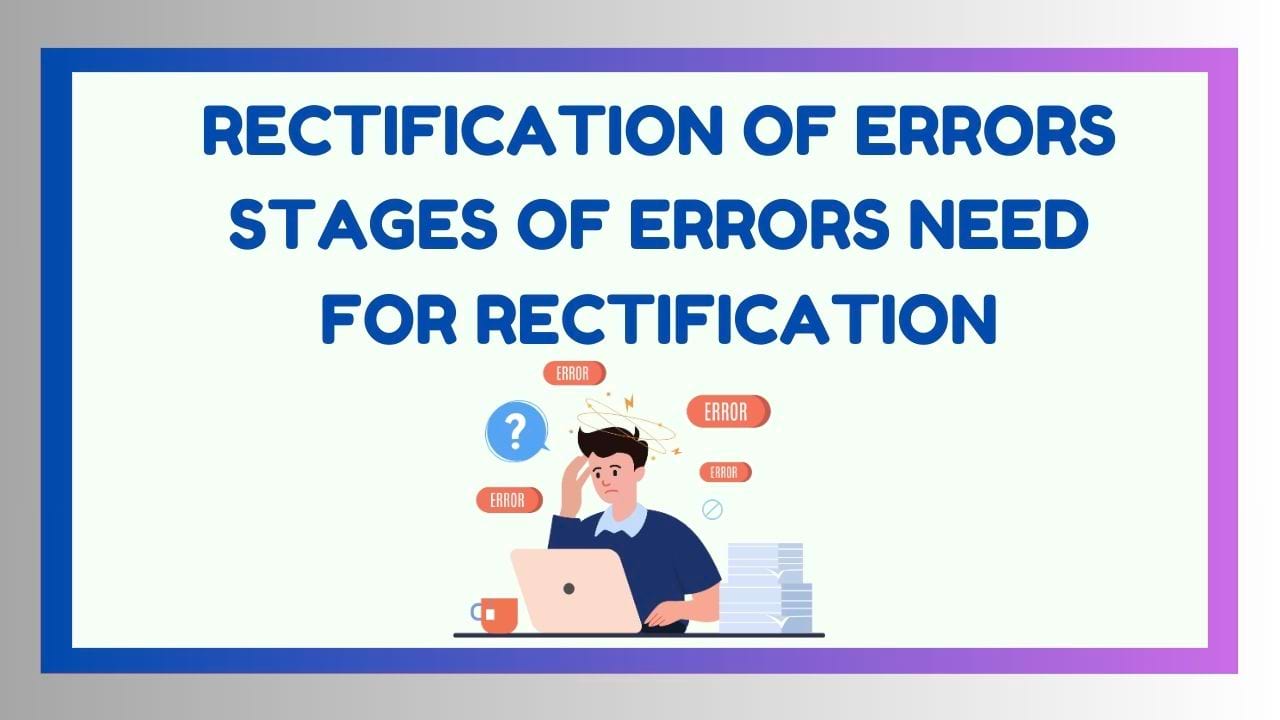Rectification of Errors: Every concern is interested in ascertaining its true profit and financial position at the close of the trading year. But despite the best efforts of the bookkeeper and the accountant, certain errors are committed in the recording of the transactions which affect the final accounts of the concern. It, therefore, becomes of utmost importance for the bookkeeper and the accountant to locate such errors and rectify them so that the correct profit and financial position of the concern may be ascertained. So whenever errors in accounting records come to notice, they should be rectified without waiting till the end of the accounting year when Trial Balance is to be prepared.
Quick Links
Rectification of Errors
It is better to rectify errors always through journal entries. However, if an error is located immediately after it has been entered, the accountant may neatly cross out the wrong amount and initial the rectification. There should not be any overwriting. If however, some time has elapsed between the commission of the error and its detection, the error should be rectified by making suitable journal entries only. You may also like Bills of Exchange.
Stages of Errors:
Errors may occur at any of the following stages of the accounting process:
At the Stage of Recording the Transactions in the Journal
The following types of errors may happen at this stage:
- i) Errors of principle,
- ii) Errors of omission,
- ii) Errors of commission.
AT THE STAGE OF POSTING THE ENTRIES IN THE LEDGER
i) Errors of omission:
- a) Partial omission,
- b) Complete omission.
ii) Errors of commission:
- a) Posting to the wrong account,
- b) Posting on the wrong side,
- c) Posting of the wrong amount.
AT THE STAGE OF BALANCING THE LEDGER ACCOUNTS
- a) Wrong totaling of accounts,
- b) Wrong balancing of accounts.
Need for Rectification of Errors:
- To present the correct accounting information.
- To show the accurate profit or loss made during the year by preparing the profit and loss account.
- To disclose the true financial position by preparing the balance sheet.
Rectification before the Preparation of Trial Balance
When errors are detected before the preparation of the trial balance, it should be ascertained whether they are one-sided errors or two-sided errors. According to the nature of errors, different steps are taken for their rectification. Must Read Features of the Ledger Account.
a) Errors Affecting One Account (One-Sided Errors): Errors affecting one account may occur due to the following reasons:
- (i) Wrong casting.
- (ii) Wrong balancing.
- (iii) Wrong posting.
- (iv) Wrong carry forward.
- (v) Forgetting to show an amount in the trial balance
For rectification of these types of errors, no journal entry is required to be passed, only the relevant account, in the ledger is to be debited (for short debit or excess credit) or is to be credited (for short credit or excess debit) according to the situation.
While rectifying one-sided errors it should be remembered that the double entry aspect of the rectifying entry will not be complete. For example, if P’s account has been debited with Rs. 365 for credit sales of Rs. 356 correctly recorded in the sales book, then the rectifying entry will be Rs. 9 made on the credit side of P’s account only. No account will be debited with this amount of Rs. 9.
(b) Errors Affecting Two or More Accounts. (Two Sided Errors): Errors which affect two or more accounts are as follows:
- (i) Errors of complete omission.
- (ii) Errors in recording in the subsidiary books.
- (iii) Errors in posting to a wrong account with or without the wrong amount.
- (iv) Errors of principle.
For rectification of these types of errors, the following steps may be taken:
- (i) Write down in the rough sheet, the correct entry necessary for recording the transaction.
- (ii) Write down in the rough sheet the entry that has been passed.
- (iii) Pass in the journal the requisite entry to arrive at the correct entry for step
- (i) and cancel the entry of step (ii).
Steps to Locate Errors:
Even if there is only a very small difference in the trial balance, the errors leading to it must be located and rectified. A small difference may be the result of several errors. The following steps will be useful in locating errors:
- i) The two columns of the trial balance should be totaled again. If in place of several accounts, only one amount has been written in the trial balance the list of such accounts should be checked and totaled again. The list of Trade receivables is the example from which the Trade receivable balance is derived.
- ii) It should be seen that the cash and bank balances have been written in the trial balance.
- iii) The exact difference in the trial balance should be established. The ledger should be gone through it is possible that a balance equal to the difference has been omitted from the trial balance. The difference should also be halved; a balance equal to half the difference may have been written in the wrong column.
- iv) The ledger accounts should be balanced again.
- v) The casting of subsidiary books should be checked again, especially if the difference is `1, `100, etc.
- vi) If the difference is very big, the balance in various accounts should be compared with the corresponding accounts in the previous period. If the figures differ materially the cases should be seen; an error may have been committed. Suppose the sales account for the current year shows a balance of `32,53,000 whereas it was `36,45,000 last year; there may be an error in the Swales Account. vii) Postings of the amounts equal to the difference or half the difference should be checked. It is possible that an amount has been omitted to be posted or has been posted on the wrong side.
- viii) If there is still a difference in the trial balance, a complete check will be necessary. The posting of all the entries including the opening entry should be checked. It may be better to begin with the nominal accounts. You may also like Users of Accounting Information.
Rectification of Errors:
Errors should never be corrected by overwriting. If immediately after making an entry it is clear that an error has been committed, it may be corrected by neatly crossing out the wrong entry and making the correct entry. If however the errors are located after some time, the correction should be made by making another suitable entry, called rectification entry. The rectification of an error depends on at which stage it is detected. An error can be detected at any one of the following stages:
- a) Before preparation of Trial Balance
- b) After Trial Balance but before the final account is drawn.
- c) After final accounts, i.e., in the next accounting period.







